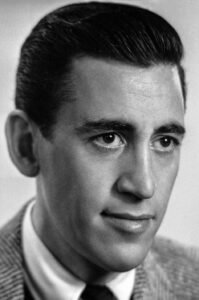Books By J.D. Salinger
- The Catcher in the Rye (1951) – standalone
- Nine Stories (1953) – short story collection
- Franny and Zooey (1961) – standalone
- Raise High the Roof Beam, Carpenters and Seymour: An Introduction (1963) – standalone
- “Hapworth 16, 1924” (1965) – short story (published in The New Yorker)
About J.D. Salinger
 J.D. Salinger, born Jerome David Salinger on January 1, 1919, in New York City, was an enigmatic and influential American author whose literary contributions continue to resonate with readers worldwide. Known for his introspective prose, vivid characterizations, and keen observations of the human condition, Salinger remains a towering figure in 20th-century literature.
J.D. Salinger, born Jerome David Salinger on January 1, 1919, in New York City, was an enigmatic and influential American author whose literary contributions continue to resonate with readers worldwide. Known for his introspective prose, vivid characterizations, and keen observations of the human condition, Salinger remains a towering figure in 20th-century literature.
Salinger rose to prominence with the publication of his seminal novel, “The Catcher in the Rye,” in 1951. This iconic coming-of-age story, narrated by the disillusioned teenager Holden Caulfield, captured the angst and alienation felt by many young people of its time and continues to be regarded as a classic of American literature.
Throughout his career, Salinger maintained a fiercely private persona, often shunning publicity and withdrawing from public life. Despite his limited output, he cultivated a devoted readership with his other works, including the short story collections “Nine Stories” (1953) and “Raise High the Roof Beam, Carpenters and Seymour: An Introduction” (1963), as well as the novella “Franny and Zooey” (1961).
Salinger’s writing style, marked by its authenticity, emotional depth, and exploration of existential themes, has left an indelible mark on generations of readers and writers alike. His nuanced portrayals of characters grappling with identity, spirituality, and societal pressures continue to resonate with readers across cultural and generational divides.
Though Salinger passed away on January 27, 2010, his literary legacy endures, and his works remain as relevant and influential as ever. Through his timeless writing, J.D. Salinger invites readers into a world of introspection, empathy, and profound human connection, ensuring his place among the literary greats of the 20th century.

